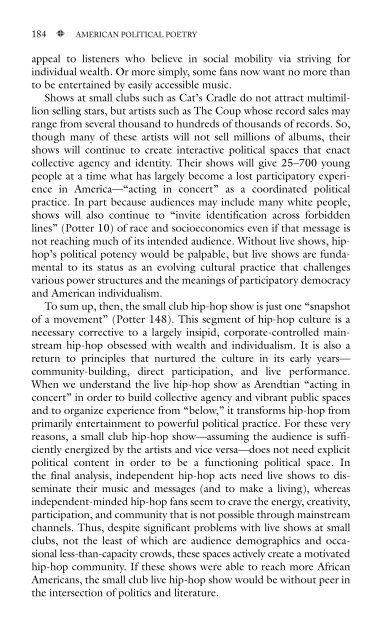american political poetry in the 21st century - STIBA Malang
american political poetry in the 21st century - STIBA Malang
american political poetry in the 21st century - STIBA Malang
Create successful ePaper yourself
Turn your PDF publications into a flip-book with our unique Google optimized e-Paper software.
184 AMERICAN POLITICAL POETRY<br />
appeal to listeners who believe <strong>in</strong> social mobility via striv<strong>in</strong>g for<br />
<strong>in</strong>dividual wealth. Or more simply, some fans now want no more than<br />
to be enterta<strong>in</strong>ed by easily accessible music.<br />
Shows at small clubs such as Cat’s Cradle do not attract multimillion<br />
sell<strong>in</strong>g stars, but artists such as The Coup whose record sales may<br />
range from several thousand to hundreds of thousands of records. So,<br />
though many of <strong>the</strong>se artists will not sell millions of albums, <strong>the</strong>ir<br />
shows will cont<strong>in</strong>ue to create <strong>in</strong>teractive <strong>political</strong> spaces that enact<br />
collective agency and identity. Their shows will give 25–700 young<br />
people at a time what has largely become a lost participatory experience<br />
<strong>in</strong> America—“act<strong>in</strong>g <strong>in</strong> concert” as a coord<strong>in</strong>ated <strong>political</strong><br />
practice. In part because audiences may <strong>in</strong>clude many white people,<br />
shows will also cont<strong>in</strong>ue to “<strong>in</strong>vite identification across forbidden<br />
l<strong>in</strong>es” (Potter 10) of race and socioeconomics even if that message is<br />
not reach<strong>in</strong>g much of its <strong>in</strong>tended audience. Without live shows, hiphop’s<br />
<strong>political</strong> potency would be palpable, but live shows are fundamental<br />
to its status as an evolv<strong>in</strong>g cultural practice that challenges<br />
various power structures and <strong>the</strong> mean<strong>in</strong>gs of participatory democracy<br />
and American <strong>in</strong>dividualism.<br />
To sum up, <strong>the</strong>n, <strong>the</strong> small club hip-hop show is just one “snapshot<br />
of a movement” (Potter 148). This segment of hip-hop culture is a<br />
necessary corrective to a largely <strong>in</strong>sipid, corporate-controlled ma<strong>in</strong>stream<br />
hip-hop obsessed with wealth and <strong>in</strong>dividualism. It is also a<br />
return to pr<strong>in</strong>ciples that nurtured <strong>the</strong> culture <strong>in</strong> its early years—<br />
community-build<strong>in</strong>g, direct participation, and live performance.<br />
When we understand <strong>the</strong> live hip-hop show as Arendtian “act<strong>in</strong>g <strong>in</strong><br />
concert” <strong>in</strong> order to build collective agency and vibrant public spaces<br />
and to organize experience from “below,” it transforms hip-hop from<br />
primarily enterta<strong>in</strong>ment to powerful <strong>political</strong> practice. For <strong>the</strong>se very<br />
reasons, a small club hip-hop show—assum<strong>in</strong>g <strong>the</strong> audience is sufficiently<br />
energized by <strong>the</strong> artists and vice versa—does not need explicit<br />
<strong>political</strong> content <strong>in</strong> order to be a function<strong>in</strong>g <strong>political</strong> space. In<br />
<strong>the</strong> f<strong>in</strong>al analysis, <strong>in</strong>dependent hip-hop acts need live shows to dissem<strong>in</strong>ate<br />
<strong>the</strong>ir music and messages (and to make a liv<strong>in</strong>g), whereas<br />
<strong>in</strong>dependent-m<strong>in</strong>ded hip-hop fans seem to crave <strong>the</strong> energy, creativity,<br />
participation, and community that is not possible through ma<strong>in</strong>stream<br />
channels. Thus, despite significant problems with live shows at small<br />
clubs, not <strong>the</strong> least of which are audience demographics and occasional<br />
less-than-capacity crowds, <strong>the</strong>se spaces actively create a motivated<br />
hip-hop community. If <strong>the</strong>se shows were able to reach more African<br />
Americans, <strong>the</strong> small club live hip-hop show would be without peer <strong>in</strong><br />
<strong>the</strong> <strong>in</strong>tersection of politics and literature.










